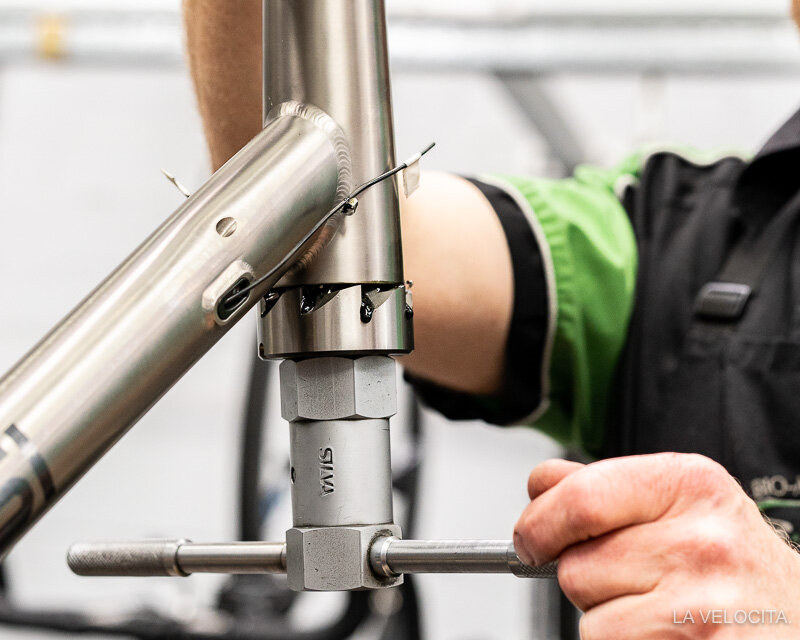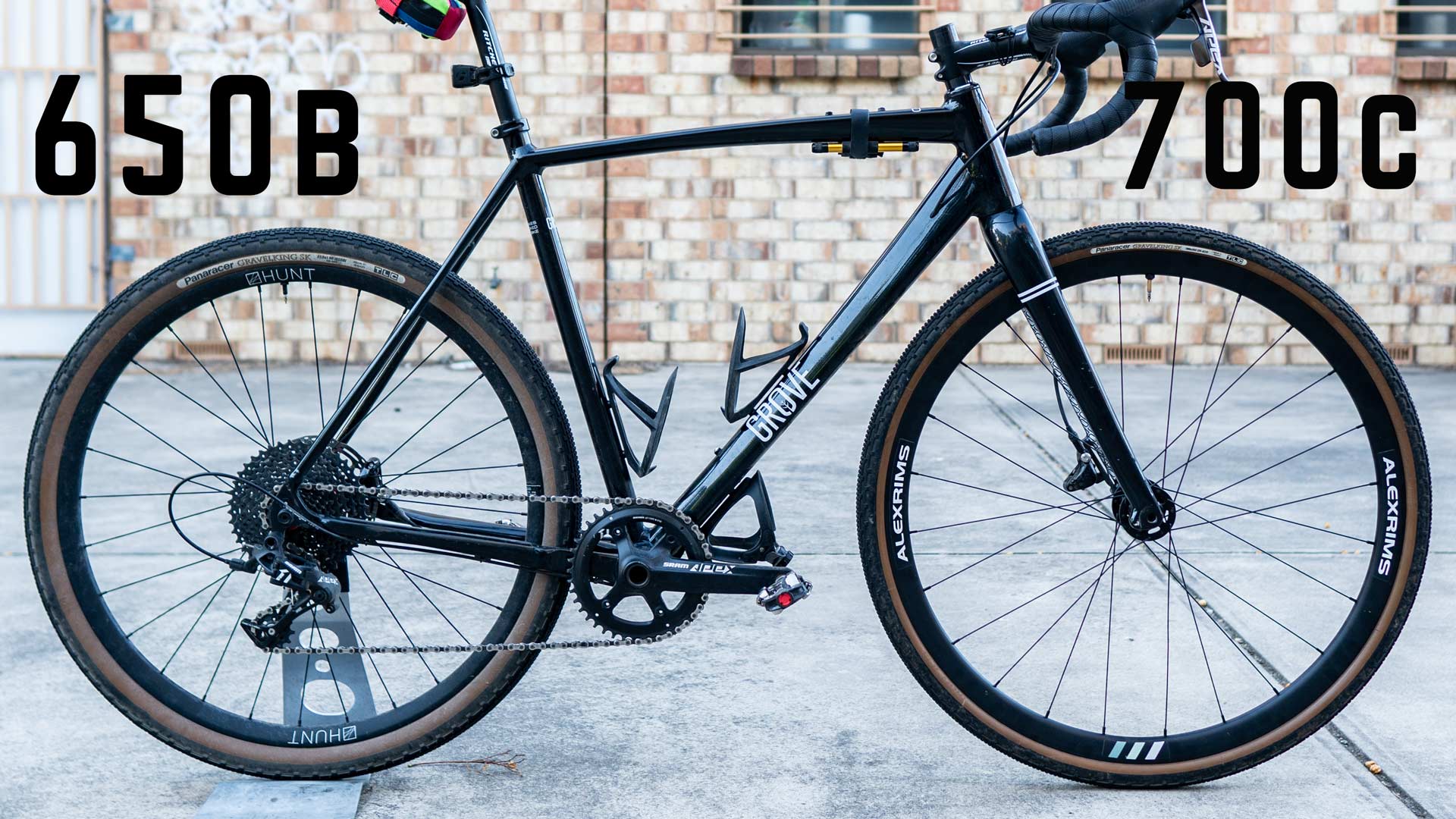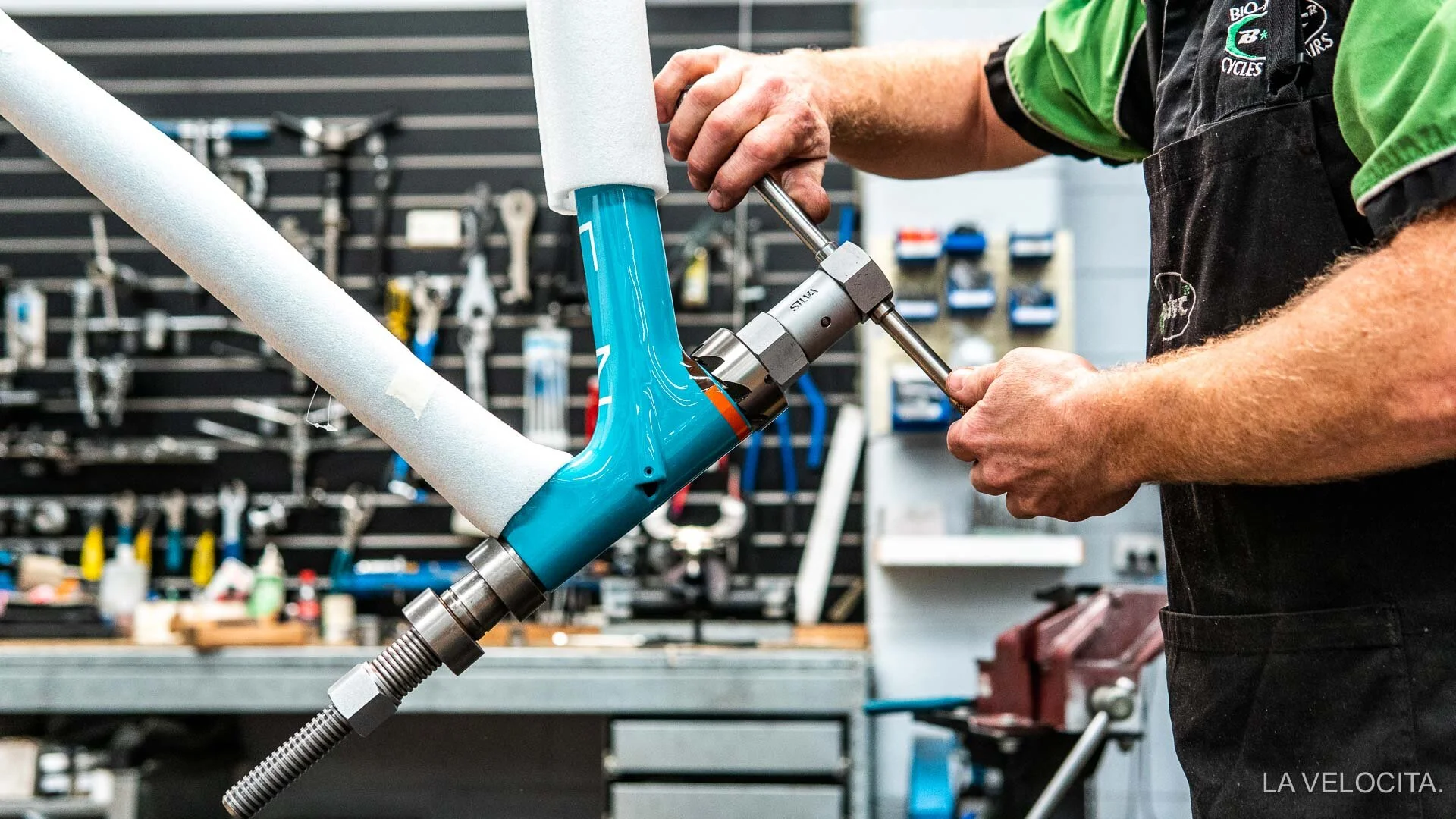Facing bike frames; why it's so important and why so few shops do it

Almost every bike needs it and is made better by it, but “facing” is rare. Let’s get nerdy and find out why
Words and Images: James Raison
Quick editor’s note; this article was so popular and people had so many questions that we wrote a follow-up about Facing carbon fibre bike frames to cover that topic and answer many other questions.
In early January I did something quite unusual: I witnessed an entire bike build from start to finish. We were lucky to be sent Shimano GRX Di2, and Bossi Bicycles sent a Grit Ti gravel frame, wheels, and finishing kit to put it on. I wanted to photograph the build coming together, hence hanging around for the whole process.
The shop I’ve used for the last 6ish years - Bio-Mechanics Cycles and Repairs (BMCR) - is known for building and servicing to a very high standard but I didn’t grasp how high until I watched the whole process unfold. There were two full hours (of the roughly eight hour total build time) dedicated to “facing” the frame and fork before a single part went near the frame.
I wanted to put an article together that explained facing: why it’s important, why few shops do it, and why people who want the best from their new bike should find a shop that does it, and does it well. So I grabbed some time with BMCR co-owner/mechanic/wizard Pete to talk about the nerdy world of facing bikes.
A couple of caveats at the top:
This isn’t a paid piece or an ad for Bio-Mechanics Cycles and Repairs. I’m a long-time customer of theirs and a nerd who likes to see bikes built well.
The frames and components that appear in this article are not chosen as a statement of their quality; they just happened to be what I was there to photograph. The titanium frame is the Bossi Grit Ti and the black frame is my own Grove R.A.D.
WHAT IS FACING
Facing is the process of removing excess material from all parts of the frame and fork that interface with another component. So what needs facing?
“Everything. Head tube, bottom bracket shell, stem, disc brake mounts, we’ll ream the seat tube as well, fork crown if possible. Basically anything that touches anything else.”
Watching facing is quite satisfying. Beefy cutting tools get threaded through the head tube or bottom bracket, doused in a lubricating solution (known as cutting oil), and handles are cranked. There’s an initial resistance from the frame before the cutting tools defeat the excess material and the turning becomes smooth. What’s left is a metal goop (known as swarf) that gets scraped into the bin *cries in titanium*, and perfectly flat and parallel surfaces to start the build right. Disc brake mounts need much smaller cutters and a drill to get them spinning and to skim off the excess material.
The confusing but satisfying sight of facing
WHY IS IT NECESSARY?
To understand why it’s necessary, bike buyers need to accept that their brand new frame leaves the factory with many imperfections. All of the surfaces mentioned above, on the vast majority of bike frames, have excess material when they leave the factory. Brands are squeezing every build to keep the end pricepoint lower and some of the finishing processes become unviable.
This isn’t a matter of retail price either. I asked Pete specifically if there’s a correlation between frame cost and the amount of facing that’s required.
“No. None at all! We’ve seen really cheap frames that are finished beautifully, then crazy-exotic frames that are just terrible and clearly haven’t been touched by the factory post-production. That being said, a lot of custom frames -- so your steel and titanium from someone like Baum’s frames -- leave perfectly, so that’s one of the things you’re paying for. If it’s an-off-the-shelf frame there are no guarantees.”
How important is facing in the age of disc brakes?
“It’s essential. When you tighten the caliper you can see it twisting and wanting to find a natural resting point. If you start with perfectly flat mounting points you can take your wheel in and out and everything stays in exactly the same spot. If the caliper is even slightly twisted, even microscopically -- it might not look like it to the naked eye because it’s conforming to the shape of the frame -- it then becomes very susceptible to how tightly you’ve done up the thru-axle or quick release skewer. That’s why pads vary when you take wheels in and out, because you might not put it up to the exact same torque.”
Facing brake mount points is critical for disc brake alignment, and makes them less likely to squeel
What about headset and bottom bracket facing?
“That’s more for bearing longevity. The bottom bracket, for example: if you think of the two surfaces being perfectly parallel, then everything is aligned and the crank axle goes through without side-loading or twisting the bearings and it can spin away happily. Facing is just as critical for press-fit bottom bracket bearing alignment. It also ensures the lip of the bottom bracket cup fits evenly and squarely against the face of the frame to hopefully eliminate clicks. It gives us a chance to qualify the concentricity of the bore as well. It’s the same with the headset. If the bearings are sitting at different angles and then you put the fork steerer through, you’re getting uneven loading on the bearings, or the fork won’t spin nicely. The headset can loosen off and prematurely wear the bearings.”
It hurts to see but this BB shell will be better for the suffering
Even stems?
Even stems. Basically, it's the same deal as the bearing seats or ends of the head tube. You want the top cap to pull down evenly against the stem and the stem to pull down evenly against the spacer and upper bearing cover. It's all about even and consistent pressure on the bearings.
A large lathe is used to precisely shave down the stem interfaces
WHY SO FEW SHOPS DO IT
Facing isn’t a common process at bike shops for a couple of reasons.
THE TOOLS ARE EXPENSIVE
Hanging on the wall is an exotic assortment of tools. They don’t just look fancy, they’re seriously expensive pieces. What does a good set of facing tools cost, then?
“That was one of the first things I invested in when I started the original incarnation of the shop. So, in 2004 that was somewhere between $15,000 and $20,000. You’ve got the tools forever, but it’s a major outlay and something you have to commit to. That’s one of the reasons why other shops don’t have them; it’s big dollars to get proper tools. You can get cheap tools but they’re rubbish. With quality tooling, you do it properly the first time. On the wall over there, each of those cutters is around $800-$900, so it adds up pretty quickly. Then you’ve got the tool that makes the cutter work, which is many hundreds more. Then it’s hundreds more per year in sharpening costs.”
Not all of these are for facing alone but you get a sense of how much is needed
IT’S TIME CONSUMING
A proper facing process of headset, bottom bracket, and disc brake mounts on frame and fork is a long process. An entire bike is built by factories in a handful of minutes, so you start to see why factories don’t want to do it. So how long does it take?
“Per frame, if I’m doing everything, it’s around two hours. It can vary by how far the frame is out. I’ve spent over an hour at times on just one set of disc mounts that are carbon and very hard on the cutters. Sometimes we’ll have to look at other tools just to do the initial work to get ready for the facing tools. It can blow out to many hours to do a complete frame.”
This goop is shredded titanium and cutting oil
WHY YOU SHOULD CONSIDER FACING
Facing is an early investment in your bike’s improved function and longevity. That said, a bike that has been faced might not be easily told apart in its early life from one that hasn’t. A new bike that’s quiet and seems to ride smoothly is what people expect and new parts can mask some of the problems that facing fixes.
Facing is something buyers should invest in early for the long-term benefits, particularly if you’re dropping big coin on your new rig. Part longevity isn’t going to be known for months or years after the bike has been built as bearings wear out quickly or components get scarred by poor alignment.
More broadly there’s a conversation about what facing services say about a shop and a mechanic. Shops who offer it as an option, and more so those who do it as a mandatory part of all builds like BMCR, are separating themselves by a willingness to invest in building better bikes whether their customers are even aware of it.











